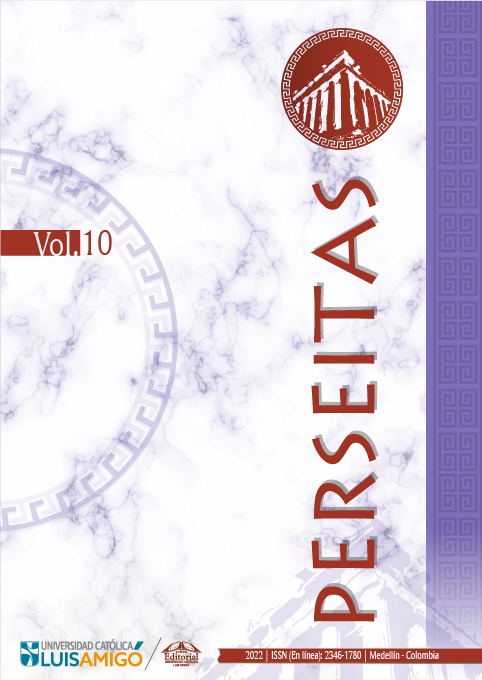Misogynist violence, love and patriarchy
DOI:
https://doi.org/10.21501/23461780.4098Keywords:
Feminism, Humanities, Love relationships, Misogyny, Morality, Patriarchy, PoliticsAbstract
There is widespread agreement in the humanistic disciplines in understanding misogyny as indicated by its etymology: hatred of women. The aim of this article is to critically review this use of the concept of misogyny and to propose a more precise meaning of it. This exercise of conceptual clarification consists of three parts. First, it is shown that the motivations that trigger misogynist reactions are not always originated by hatred; in some cases, they are interwoven with love or affection. Second, the close relationship between misogyny and patriarchy is highlighted, showing that misogyny is essentially a political phenomenon rather than a psychiatric pathology or a psychogenic tendency exclusive to men. Finally, it is pointed out that misogyny is a moral evil because it is based on false judgments and irrational demands for moral goods that seriously harm the dignity of women and are protected by the patriarchal system itself. It is concluded that the displacement of misogyny from the psychogenetic field to the political and moral field makes it possible to understand it as a more every day and recurrent phenomenon, and as a sociopolitical evil that must be fought collectively.
Downloads
References
Bailey, M., & Trudy. (2018). On misogynoir: citation, erasure, and plagiarism. Feminist Media Studies, 18(4), 762-768. http://dx.doi.org/10.1080/14680777.2018.1447395
Bloom, A. (1996). Amor y amistad. Andrés Bello.
Buller, A. M., Pichon, M., Chevalier, C., & Treves-Kagan, S. (2022). The role of gender and romantic jealousy in intimate partner violence against women, a mixed-methods study in Northern Ecuador. Culture, Health
& Sexuality. An International Journal for Research, Intervention and Care, 1-18. https://doi.org/10.1080/13691058.2022.2031299
Butler, J. (2017). Cuerpos aliados y lucha política. Hacia una teoría performativa de la asamblea. Paidós.
Capetillo, L. (1907). Ensayos libertarios. Real Hermanos. Carballo González, M. S. (2015). La misoginia a través de la historia. Pirineos, 11, 28-31. https://sede.educacion.gob.es/publiventa/pirineos-n-11-revista-
de-la-consejeria-de-educacion-en-andorra/ensenanza-lenguaespanola/20628
Cazés Menache, D. (2005). La misoginia: ideología de las relaciones humanas. Una introducción. En D. Cazés Menache y F. Huerta Rojas (Eds.), Hombres ante la misoginia. Miradas críticas (pp. 11-48). Plaza y Valdés.
Cazés Menache, D. (2013). La misoginia: apuntes y reflexiones. Revista de la Universidad de México, 108, 5-12. https://www.revistadelauniversidad.mx/download/248fd993-e3ae-407a-a99c-03bd7d67e538?filename=lamisoginia-apuntes-y-reflexiones-de-adan-a-orfeo
Chang, N. V. (1996). I Just Lost Myself. Psychological Abuse of Women in Marriage. Praeger.
Dragiewicz, M., Burgess, J., Matamoros-Fernández, A., Salter, M., Suzor, N. P., Woodlock, D., & Harris, B. (2018). Technology facilitated coercive control: domestic violence and the competing roles of digital media platforms. Feminist Media Studies, 18(4), 609-625. https://doi.org/10.1080/14680777.2018.1447341
Dziegielewski, S. F., Campbell, K., & Turnage, B. F. (2005). Domestic Violence. Focus Groups from the Survivors’ Perspective. Journal of Human Behavior in the Social Environment, 11(2), 9-23. https://doi.org/10.1300/J137v11n02_02
Ferrer, V., & Bosch, E. (2000). Violencia de género y misoginia: reflexiones psicosociales sobre un posible factor explicativo. Papeles del psicólogo, (75), 13-19. http://www.papelesdelpsicologo.es/resumen?pii=815
Firestone, S. (1971). The Dialectic of Sex: The Case For Feminist Revolution. Bantam Book.
Forward, S., & Torres, J. (2002). Men Who Hate Women & The Woman Who Love Them. Bantam Books.
Gilmore, D. (2001). Misogyny. The Male Malady. University of Pennsylvania.
Ging, D., & Siapera, E. (2018). Special issue on online misogyny. Feminist Media Studies, 18(4), 515-524. http://dx.doi.org/10.1080/14680777.2018.1447345
Gregoratto, F. (2016). Why Love Kills: Power, Gender Dichotomy, and Romantic Femicide. Hypathia, 32 (1), 135-151. https://doi.org/10.1111/hypa.12308
Hass, J., & Vogt, K. M. (2019). Love and Hatred. En A. M. Martin (Ed.), The Routledge Handbook of Love in Philosophy (pp. 344-356). Routledge.
Hattery, A. (2008). Intimate Partner Violence. Rowman & Littlefield Publishers.
Heller, A. (2006). The Shame of Trauma, the Trauma of Shame. Radical Society, 3(32), 23-34.
Honneth, A. (2014). Freedom’s Rigth. The Social Fundations of Democratic Life. Polity Press.
Hooks, B. (2001). All about love: new visions. HarperCollings.
Ibaceta Watson, F. (2004). Hombres que ejercen violencia en la pareja: reflexiones de una experiencia de atención individual. Terapia Psicológica, 22(2), 157-164. http://www.redalyc.org/articulo.oa?id=78522206
Jane, E. A. (2017). Misogyny Online. A Short (and Brutish) History. Sage.
Jónasdóttir, A. G. (1993). El poder del amor. ¿Le importa el sexo a la democracia? Cátedra.
Lagarde y de los Ríos. M. M. (2001). Claves para una negociación feminista del amor. Puntos de Encuentro.
Manne, K. (2018). Down Girl: The Logic of Misogyny. Oxford University Press.
Manne, K. (2020). Entitled. How Male Privilege Hurts Women. Crown.
Mantilla, K. (2015). Gendertrolling: how misogyny went viral. Praeger.
Millet, K. (2000). Sexual Politics. University of Illinois Press.
Moreno Abello, M. L. (2014). En diciembre llegaban las brisas. Alfaguara.
Moreno Abello, M. L. (2020). El tiempo de las amazonas. Alfaguara.
Nussbaum, M. C. (2001). Upheavals of Thought: The Intelligence of Emotions. Cambridge University Press.
Olivos Santoyo, L. F. (2005). Hombres feministas y misóginos. Una contradicción posible. En D. Cazés Menache y F. Huerta Rojas (Eds.), Hombres ante la misoginia. Miradas críticas (pp. 49-76). Plaza y Valdés.
ONU MUJERES. (noviembre de 2020). Hechos y cifras: Poner fin a la violencia contra las mujeres. https://www.unwomen.org/es/what-we-do/ending-violence-against-women/facts-and-figures#notes
Perelló Tomás, F. (2019). Amor y misoginia. A propósito de amor fou de Marta Sanz. Arxius de Sociología, (40), 31-36. https://dialnet.unirioja.es/servlet/articulo?codigo=7038137
Pocock, M., Jackson, D., & Bradbury-Jones, C. (2020). Intimate partner violence and the power of love: A qualitative systematic review. Health Care for Women International, 41(6), 621-646. https://doi.org/10.1080/07399332.2019.1621318
Real Academia Española. (2020). Diccionario de la lengua española (edición del tricentenario). https://dle.rae.es/misoginia
Robles, K. (2021). El fenómeno del conejo malo «Bad Bunny»: ¿reivindicación de las masculinidades o reproducción de la misoginia? Revista Punto Género, 15, 257-276. Doi: 10.5354/0719-0417.2021.64408
Ruiz Navarro, C. (2019). Las mujeres que luchan, se encuentran. Penguin Random House.
Segato, R. L. (2002). La estructura de género y el mandato de la violación. En R. L. Segato, Las estructuras elementales de la violencia: ensayos sobre género entre la antropología, el psicoanálisis y los derechos humanos (pp. 21-53). Universidad Nacional de Quilmes.
Singer, I. (2017). La naturaleza del amor. El mundo moderno. Mandius.
Smith, M., Nunley, B., & Martin, E. (2013). Intimate Partner Violence and the Meaning of Love. Issues in Mental Health Nursing, 34(6), 395-401. https://doi.org/10.3109/01612840.2012.762960
Solomon, R. (1993). The Passions. Emotions and the Meaning of Life. Hackett Publishing Company.
Varela, N. (2012). La nueva misoginia. Revista Europea de Derechos Fundamentales, 1(19), 25-48. https://dialnet.unirioja.es/descarga/articulo/4055493.pdf
Vergés Bosch, N., & Gil-Juárez, A. (2021). Un acercamiento situado a las violencias machistas online y a las formas de contrarrestarlas. Revista Estudos Feministas, 29(3), 1-15.https://doi.org/10.1590/1806-9584-2021v29n374588
Vickery, J. R., & Everbach, T. (2018). Mediating Misogyny Gender, Technology, and Harassment. Palgrave Macmillan.
Wood, J. T. (2001). The Normalisation of Violence in Heterosexual Romantic Relationships: Women’s Narratives of Love and Violence. Journal of Social and Personal Relationships, 18(2), 239–261. https://doi.org/10.1177/0265407501182005
Published
How to Cite
Issue
Section
License
Copyright (c) 2022 Perseitas

This work is licensed under a Creative Commons Attribution-NonCommercial-NoDerivatives 4.0 International License.
La revista y los textos individuales que en esta se divulgan están protegidos por las leyes de copyright y por los términos y condiciones de la Licencia Creative Commons Atribución-No Comercial-Sin Derivar 4.0 Internacional.
















